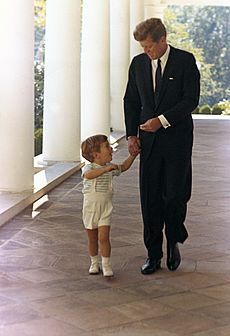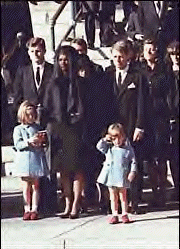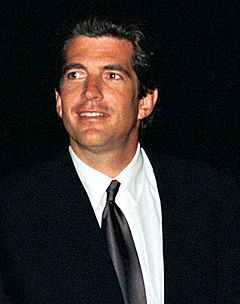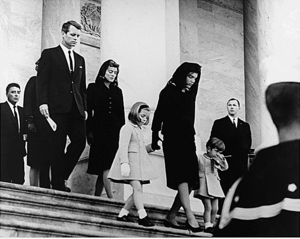John F. Kennedy Jr. facts for kids
Quick facts for kids
John F. Kennedy Jr.
|
|
|---|---|

Kennedy in 1999
|
|
| Born |
John Fitzgerald Kennedy Jr.
November 25, 1960 Washington, D.C., U.S.
|
| Died | July 16, 1999 (aged 38) Atlantic Ocean, near Martha's Vineyard, Massachusetts, U.S.
|
| Cause of death | Plane crash |
| Alma mater | |
| Occupation |
|
| Political party | Democratic |
| Spouse(s) | |
| Parent(s) | |
| Family | Kennedy family |
John Fitzgerald Kennedy Jr. (November 25, 1960 – July 16, 1999), often referred to as John-John or JFK Jr., was an American attorney, journalist, and magazine publisher. He was a son of John F. Kennedy, the 35th president of the United States, and First Lady Jacqueline Kennedy, and a younger brother of U.S. Ambassador Caroline Kennedy. Three days after his father was assassinated, he rendered a final salute during the funeral procession on his third birthday.
From his childhood years at the White House, Kennedy was the subject of much media scrutiny, and later became a popular social figure in Manhattan. Trained as a lawyer, he worked as a New York City assistant district attorney for almost four years. In 1995, he launched George magazine, using his political and celebrity status to publicize it. He died in a plane crash in 1999 at the age of 38.
Contents
Early life
John Fitzgerald Kennedy Jr. was born on November 25, 1960, at Georgetown University Hospital two weeks after his father and namesake, Massachusetts senator John F. Kennedy, was elected president. His father was sworn in as president two months after John Jr. was born. His parents had a stillborn daughter four years before John Jr.'s birth. John Jr. had an older sister, Caroline, and a younger brother, Patrick, who died two days after his premature birth in 1963 of Respiratory Distress Syndrome. His putative nickname, "John-John", came from a reporter who misheard JFK calling him "John" twice in quick succession; the name was not used by his family.
John Jr. lived in the White House during the first three years of his life and remained in the public spotlight as a young adult. His father was assassinated on November 22, 1963, and the state funeral was held three days later, on John Jr.'s third birthday. In a moment that became a famous scene of his life, John Jr. stepped forward and rendered a final salute as his father's flag-draped casket was carried out from St. Matthew's Cathedral. NBC News vice president Julian Goodman called the shot "the most impressive...shot in the history of television" which was setup by NBC Director Charles Jones who was working for the pool. Lyndon B. Johnson wrote his first letter as president to Kennedy and told him that he "can always be proud" of his father. Stan Stearns, who took the image, served as chief White House photographer during the LBJ White House years and over the years, showed Johnson the image of Kennedy saluting the casket, as the salute was a symbol of what Johnson said in his letter to him.
The family continued with their plans for a birthday party to demonstrate that the Kennedys would go on despite the death of the president.
After President Kennedy was assassinated in 1963, Jacqueline Kennedy moved her family, after brief residency in the Georgetown area of Washington, to a luxury apartment on the Upper East Side of Manhattan in New York City, where Kennedy Jr. grew up. In 1967, his mother took him and Caroline on a six-week "sentimental journey" to Ireland, where they met President Éamon de Valera and visited the Kennedy ancestral home in Dunganstown.
Mother's remarriage
In 1968, Jackie took Caroline and John Jr. out of the United States. The same year, she married Greek shipping tycoon Aristotle Onassis, and the family went to live on his private island of Skorpios. When Onassis died in 1975, he left Kennedy $25,000, though Jacqueline was able to renegotiate the will, and acquired $20 million for herself and her children.
In 1971, Kennedy returned to the White House with his mother and sister for the first time since the assassination. President Richard Nixon's daughters gave Kennedy a tour that included his old bedroom, and Nixon showed him the Resolute desk under which his father had let him play.
Education
Kennedy attended private schools in Manhattan, starting at Saint David's School and moving to Collegiate School, which he attended from third through tenth grade. He completed his education at Phillips Academy in Andover, Massachusetts. After graduating, he accompanied his mother on a trip to Africa. He rescued his group while on a pioneering course, which had gotten lost for two days without food or water, and won points for leadership.
In 1976, Kennedy and his cousin visited an earthquake disaster zone at Rabinal in Guatemala, helping with heavy building work and distributing food. The local priest said that they "ate what the people of Rabinal ate and dressed in Guatemalan clothes and slept in tents like most of the earthquake victims," adding that the two "did more for their country's image" in Guatemala "than a roomful of ambassadors." On his 16th birthday, Kennedy's Secret Service protection ended and he spent the summer of 1978 working as a wrangler in Wyoming. In 1979, the John F. Kennedy Presidential Library and Museum in Boston was dedicated, and Kennedy made his first major speech, reciting Stephen Spender's poem "I Think Continually of Those Who Were Truly Great."
Kennedy attended Brown University, where he majored in American studies. There, he co-founded a student discussion group that focused on contemporary issues such as apartheid in South Africa, gun control, and civil rights. Visiting South Africa during a summer break, he was appalled by apartheid, and arranged for U.N. ambassador Andrew Young to speak about the topic at Brown. By his junior year at Brown, he had moved off campus to live with several other students in a shared house, and spent time at Xenon, a club owned by Howard Stein. Kennedy was initiated into Phi Psi, a local social fraternity that had been the Rhode Island Alpha Chapter of national Phi Kappa Psi fraternity until 1978.
In January 1983, Kennedy's Massachusetts driver's license was suspended after he received more than three speeding summonses in a twelve-month period, and failed to appear at a hearing. The family's lawyer explained he most likely "became immersed in exams and just forgot the date of the hearing." He graduated that same year with a bachelor's degree in American studies, and then took a break, traveling to India and spending some time at the University of Delhi where he did his post-graduate work and he met Mother Teresa. He also worked with some of the Kennedy special-interest projects, including the East Harlem School at Exodus House and Reaching Up.
Career
After the 1984 Democratic Convention in San Francisco, Kennedy returned to New York and earned $20,000 a year in a position at the Office of Business Development, where his boss reflected that he worked "in the same crummy cubbyhole as everybody else. I heaped on the work and was always pleased." He continued there as deputy director of the 42nd Street Development Corporation in 1986, conducting negotiations with developers and city agencies. In 1988, he became a summer associate at Manatt, Phelps, Rothenberg & Phillips, a Los Angeles law firm with strong connections to the Democratic Party. There, Kennedy worked for Charlie Manatt, his uncle Ted Kennedy's law school roommate.
From 1989, Kennedy headed Reaching Up, a nonprofit group which provided educational and other opportunities for workers who helped people with disabilities. William Ebenstein, executive director of Reaching Up, said, "He was always concerned with the working poor, and his family always had an interest in helping them."
In 1989, Kennedy earned a J.D. degree from the New York University School of Law. He then failed the New York bar exam twice, before passing on his third try in July 1990. After failing the exam for a second time, Kennedy vowed that he would take it continuously until he was ninety-five years old or passed. If he had failed a third time, he would have been ineligible to serve as a prosecutor in the Manhattan District Attorney's Office, where he worked for the next four years. On August 29, 1991, Kennedy won his first case as a prosecutor.
In the summer of 1992, he worked as a journalist and was commissioned by The New York Times to write an article about his kayaking expedition to the Åland Archipelago, where he saved one of his friends from the water when his kayak capsized. He then considered creating a magazine with his friend, public-relations magnate Michael J. Berman—a plan which his mother thought too risky. In his 2000 book The Day John Died, Christopher Andersen wrote that Jacqueline had also worried that her son would die in a plane crash, and asked her longtime companion Maurice Tempelsman "to do whatever it took to keep John from becoming a pilot".
Acting
Meanwhile, Kennedy had done a bit of acting, which was one of his passions (he had appeared in many plays while at Brown). He expressed interest in acting as a career, but his mother strongly disapproved of it, considering it an unsuitable profession. On August 4, 1985, Kennedy made his New York acting debut in front of an invitation-only audience at the Irish Theater on Manhattan's West Side. Executive director of the Irish Arts Center, Nye Heron, said that Kennedy was "one of the best young actors I've seen in years". Kennedy's director, Robin Saex, stated, "He has an earnestness that just shines through." Kennedy's largest acting role was playing a fictionalized version of himself in the eighth-season episode of the sitcom Murphy Brown called "Altered States". In this episode, Kennedy visits Brown at her office, in order to promote a magazine he is publishing.
George magazine
In 1995, Kennedy and Michael Berman founded George, a glossy, politics-as-lifestyle and fashion monthly, with Kennedy controlling 50 percent of the shares. Kennedy officially launched the magazine at a news conference in Manhattan on September 8, and joked that he had not seen so many reporters in one place since he failed his first bar exam.
Each issue of the magazine contained an editor's column and interviews written by Kennedy, who believed they could make politics "accessible by covering it in an entertaining and compelling way" which would allow "popular interest and involvement" to follow. Kennedy did interviews with Louis Farrakhan, Billy Graham, Garth Brooks, and others.
By early 1997, Kennedy and Berman found themselves locked in a power struggle. Eventually, Berman sold his share of the company, and Kennedy took on Berman's responsibilities himself. Though the magazine had already begun to decline in popularity before Berman left, his departure was followed by a rapid drop in sales.
After his death, the magazine was bought out by Hachette, but it folded in early 2001.
Personal life

on September 21, 1996, Kennedy married Carolyn Bessette in a private ceremony on Cumberland Island.
Piloting
Kennedy took flying lessons at the Flight Safety Academy in Vero Beach, Florida. In April 1998, he received his pilot's license, which he had aspired to since he was a child.
The death of his cousin Michael in a skiing accident prompted John to take a hiatus from his piloting lessons for three months. His sister Caroline hoped this would be permanent, but when he resumed, she did little to stop him.
Death
On July 16, 1999, Kennedy departed from Fairfield, New Jersey at the controls of his Piper Saratoga light aircraft. He was traveling with his wife Carolyn and sister-in-law Lauren Bessette to attend the wedding of his cousin Rory Kennedy at Martha's Vineyard, Massachusetts. He had purchased the plane on April 28, 1999, from Air Bound Aviation. Kennedy had checked in with the control tower at the Martha's Vineyard Airport, but the plane was reported missing after it failed to arrive on schedule.
On July 19, the fragments of Kennedy's plane were found by a NOAA. The next day, Navy divers descended into the water. The divers found part of the shattered plane strewn over a broad area of seabed 120 feet (37 m) below the surface of the Atlantic Ocean. The search ended in the late afternoon of July 21, when the three bodies were recovered from the ocean floor by Navy divers and taken by motorcade to the county medical examiner's office.
The National Transportation Safety Board (NTSB) determined that pilot error was the probable cause of the crash: "Kennedy's failure to maintain control of the airplane during a descent over water at night, which was a result of spatial disorientation."
On July 21, they were cremated in the Mayflower Cemetery crematorium. Ted Kennedy favored a public service for John while Caroline Kennedy insisted on family privacy. On the morning of July 22, their ashes were scattered at sea from the Navy destroyer USS Briscoe off the coast of Martha's Vineyard.
A memorial service was held for Kennedy on July 23, 1999, at the Church of St. Thomas More, which was a parish that Kennedy had often attended with his mother and sister. The invitation-only service was attended by hundreds of mourners, including President Bill Clinton, who presented the family with photo albums of John and Carolyn on their visit to the White House from the previous year.
Legacy
John F. Kennedy Jr. was the first child ever born to a President-elect of the United States. On the occasion of the 50th anniversary of the assassination of John Jr.'s father on November 22, 1963, the New York Daily News re-ran the famous photograph of the three-year-old John Jr. saluting his father's coffin during the funeral procession. Photographer Dan Farrell, who took the photo, called it "the saddest thing I've ever seen in my whole life".
In 2000, Reaching Up, the organization which Kennedy founded in 1989, joined with The City University of New York to establish the John F. Kennedy Jr. Institute. On September 19, 2003, the ARCO Forum at Harvard University's Kennedy School of Government was renamed to the John F. Kennedy Jr. Forum of Public Affairs.
Images for kids
-
JFK Jr. with his father at the White House at age two, 1963
See also
 In Spanish: John F. Kennedy Jr. para niños
In Spanish: John F. Kennedy Jr. para niños









